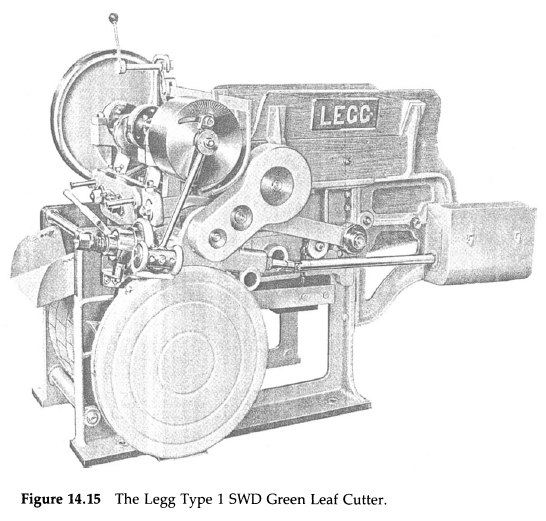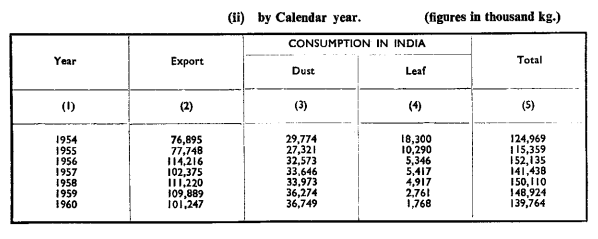The mechanical evolution of tea production began as early as the 1880s,2 attempting to modernize and streamline the traditional Chinese techniques brought to India. These early machines often dealt with the time-consuming methods of rolling, drying and firing, and improving upon existing orthodox techniques. The early 1900s saw the rise of unorthodox manufacture, exploring different means and ‘shortcuts’ in leaf disruption (focusing on leaf maceration to kickstart fermentation, or to forego withering). These two eras correlate with Harler’s third and fourth Phases of tea making, respectively.2
Withering
Before tea is rolled, it undergoes withering, a process which reduces the moisture and softens the leaf, allowing for easier rolling. Under-withered or unwithered leaf is too tough to roll (unwithered constitutes a leaf moisture content of 75-80%1, 2, 4, 7), and will often flake and spill off of the rolling table.2 Leaf being rolled also generates mechanical heat; the heat itself is important in starting the ‘fermentation’ (oxidation) process of tea production, however too MUCH heat damages tea, leading to a dull cup.1, 2
As tea production spread into the different regions of India and as far as Sri Lanka, tea production was forced to adapt to the variety of climates. As withering required adequate temperatures to proceed, northern production regions often ran into problems, resulting in underwithered leaf being rolled, and incomplete fermentation and reactions, which resulted in undesirable cups. Further, in the south, withering and rolling combined with poor air circulation caused leaf to easily overheat.
Precursor to Legg-Cut
In 1923, the manager of the Cachar tea factory sought to find a way to make unwithered leaf easier to roll. He ran fresh tea leaves through a chaff-cutter (a small bladed wheel used for cutting straw and hay), creating thin strips of leaf that immediately reduced spillage when rolled, but produced a tough, flaky tea. The resulting product was mostly dust and fannings, producing a brassy liquor.1, 2

Figure 1: Vintage Chaff-Cutter
The use of the chaff-cutter was an early precursor, quickly expanded upon in 1925 in the Dooars when a tobacco-cutter was used for the same purpose. The tobacco-cutter was the template used for the later development of the legg or legge green leaf cutters.1, 2 The unwithered, cut leaf rolled more easily, and also generated less mechanical heat, making it suitable both for regions where leaf was prone to overheating, and areas where it was too cold for proper withering to proceed.1
Napier Ford is credited with the invention of the legge(sic)-cutter machine some time in the early 1950s, Sri Lanka.7 Looking into it (as he’s only credited as such in a single work), a Napier Ford is listed as a visitor of the Tea Research Institute of Ceylon in the 1960s. A patent filed in 1969 (US3584668 A) for knives to be used in a legg-cut machine references a Napier Ford:
“In the Napier Ford method for the processing of tea, the freshly plucked green leaves are cut into shreds to initiate the fermentation. The resultant product is known in the trade as Legg cut tea or fresh cut tea.”
Interestingly, Harler2 states the legg-cut process never caught on into Sri Lanka, which continued to favour orthodox manufacture as India converted.
The Legg-cut Process

Figure 2: Legg Type 1 SWD Green Leaf Cutter3
The legg type green leaf cutter uses pressure to consolidate leaf and push it through a small opening, where it is cut, as a large cake, into strips of adjustable length (0.625-0.025cm across; 0.078cm being the common width, with a double-cut applied). This is followed by a short, light roll, using a system on a flat table with a centre cone, followed by a brief fermentation and then firing; the result is composed mostly of fannings and dust, and the tea does not keep particularly well.1, 2
The assamica leaf is about 0.025cm thick, with cells 0.0025cm across; on legg-cut, a 0.039cm wide cut is sufficient to break or disrupt all cells (especially if done with a dull knife).2 This form of leaf disruption means no withering is needed, and also reduces the number of rollers needed by 1/3 that used in orthodox manufacture.1
However, legg-cut teas often require unique rollers, as the orthodox rollers do not cope well with the flakyness of the unwithered leaf. A foursome (a type of ball-breaking machine) is also often needed after rolling, and before the leaf is fermented.1 On top of this, a double-cut is often necessary for uniform leaf, and this is accomplished by placing two legg-cutters in series. The individual legg-cut machine has a relatively low capacity alongside its successors, and needs multiple units for a reasonable output.3 Additional driers are also required.2
The resulting tea was of a very even size, pattern and grade,3, 7 with a non-standard twist in the leaf that was praised at the time.7 Despite this, the leaf was criticized for not having sufficient leaf disruption (when compared alongside the maceration seen later in CTC and LTP), and the juices from cutting could cause an uneven or incomplete fermentation (alongside some serious concerns with bacterial contamination inherent in the design of the machine).1 The size and density of the resulting leaf also wasn’t suitable for use in teabags, which were on the rise at the time,3 and the tea didn’t keep long when compared to orthodox and CTC.1
Rotorvane, an alternative distortion process invented in 1958 to replace rolling, has been combined with legg-cut with some success (running legg-cut first and then rotorvane). The tea needed time to cool between legg-cut and rotorvane processes, and fresh tea stored overnight before processing provided a brighter cup than when fresh tea is processed.1 In contrast, rotorvane has been much more successful with CTC, where the two can be set up as an almost continuous process (withered leaf into a rotorvane and then CTC).1
Because of the maceration process found in legg-cut, CTC and rotorvane, sorting of these teas is impossible (meaning there resulted in a larger proportion of stalks and other fibre in the final tea), and the resulting product is always graded as fanning and dust, based on the particle size. Because of this, these techniques were often favoured for off-season production (such as during the monsoon), where bulk tea leaf is used and no emphasis is put on the collection of fines.3
Region-Locked
Although the reduction in mechanical heat production made it appropriate for use in southern India as well, its main application remained in northern India, where temperatures were often too low for an adequate wither.3, 2 In 1961, 1.6 million kilograms came out of southern India, whereas 24.6 million came out of northern India, about 15x more.5 By 1974, more than 45% of the tea production coming out of the Dooars and the Terai, Nepal, was legg-cut.1
However, its nearest neighbour, Sri Lanka, held true to orthodox manufacture and never adopted legg-cut.1, 2 Sri Lanka tended to favour a harder wither than Assam and India when it came to orthodox tea production, and the brassy, broken liquor of legg-cut teas were seen as inferior.1, 2
Legg-cut still saw some small fame outside, reaching as far as Guatemala, in central America, where it was still producing legg-cut teas as late as the 1980s.7
Cuppa & Chemistry
Legg-cut was originally introduced to prevent an alternative to withering; this produced a flaky tea, with a strong, bright liquor, and a brassy, “raw” or green flavour. To combat this, Tocklai experimented with withering legg-cut before-hand, but found that a physical wither produced a dull liquid, and tasters unanimously sided with the unwithered cup.1 Although the tea didn’t benefit from physical withering, chemical withering through storage was thought to help.2
Physical withering is the process of moisture-loss that is needed to make the leaf soft and malleable for rolling; it occurs much more quickly than chemical wither, which begins immediately after plucking but is independent of moisture content. Chemical withering depends on time and temperature, and is essentially the break-down of molecules, release of carbon dioxide (in ‘leaf-death’), and start of enzymic activity that ultimately leads into oxidation or ‘fermentation’.1, 4
The brassy or raw character of legg-cut teas is likely due to unfermented catechins,1, 2 and perhaps a higher ratio of TF, or theaflavins, an oxidation product in black tea that is responsible for the yellow colouring and briskness of the infusion.1 It’s produced early in the oxidation of tea, and falls off relatively quickly when compared to TR, thearubigin, the red-colouring product that is responsible for the body and strength of a tea.1 This could likely explain the dull character found in experiments with physically withered legg-cut teas.
Werkhoven’s Tea Processing1 proposes a rough TF-TR ratio of 1:10 to 1:12 for optimal strength and brightness of the liquor; E. A. H. Roberts’ study6 of TF and TR content using spectrophometrics shows a rough ratio of 1:13.61 for legg-cut teas (TF: 1.08% and TR: 14.7%, Table 2, Duars[sic]), not taking into account the variation of TR measurements (better explained by the paper than me: measured by spectrophometrics, TR has a range of possible wavelengths as it is made up of a mixture of compounds, whereas TF has only one constant wavelength, making it a standard measurement). Robert goes on to explain that both legg-cut and CTC teas show increased TF and TR contents, and an increase in the ratio of TF to TR, due to the more severe leaf distortion when compared to orthodox manufacture; this results in the increased brightness, and greater depth of colour normally associated with these unorthodox manufacturing techniques.6
The unfermented catechins, or ‘greenness’ of legg-cut teas could also go towards explaining its poor keeping qualities, as green teas in general keep for a much shorter period than fully oxidized black teas.
The Decline of Legg-cut Teas
No work sets down a concrete timeline for legg-cut tea, but those published after the 70s generally agree that it died out before the 80s. By examining works published in that time, as well as older archived data, we get a cleaner picture of when the process declined and what other processes were active at the time.
In 1925 Assam, the Tea Miller was invented, a forerunner to the CTC machine which soon followed in the 1930s. It yielded a harsh liquid and was quickly discarded. The CTC machine was created by W. McKercher, and consisted of two metal rollers working to mangle softly withered tea leaf at up to 700 revolutions a minute. It dealt poorly with unwithered leaf, and was not formally accepted as an alternative until 1945 and onward. But by the 1960s, two thirds of Indian teas were CTC.1, 2 Harler2 claims that by 1974, over 45% of tea production in the Dooars and Terai were still legg-cut. The Tea Board of India’s archived data shows a very steady decline (see Table 1), with an output for that year of 1.7 million kg for all of India.5 Table 1 shows the rise of the CTC process alongside the steady decline of legg-cut teas.5
Teabags were also quickly on the rise; CTC tea resulted in small pellets that packed together remarkably well. The dense tea was very suitable for teabags, whereas legg-cut teas and orthodox leaf didn’t compact well enough to fill teabags adequately.3 CTC and dust became the favoured filler for paper teabags.
| CTC | Ortho | Legg-cut | Green | Instant | Total | |
| 1961 | 120.9 | 201.4 | 26.2 | 4.7 | – | 353.2 |
| 1963 | 147.1 | 168.1 | 26.4 | 3.7 | – | 345.3 |
| 1964 | 175.4 | 164.7 | 26.9 | 4.3 | – | 371.3 |
| 1965 | 168.8 | 166.6 | 26.7 | 3.2 | – | 365.3 |
| 1966 | 181.7 | 165.4 | 21.9 | 6.0 | – | 375.0 |
| 1967 | 202.0 | 157.0 | 20.2 | 4.7 | – | 383.9 |
| 1968 | 212.8 | 162.8 | 19.1 | 6.7 | 0.1 | 401.5 |
| 1969 | 217.5 | 150.8 | 16.6 | 7.5 | 0.2 | 392.4 |
| 1970 | 249.1 | 144.6 | 15.6 | 7.9 | 0.3 | 417.5 |
| 1971 | 239.1 | 174.9 | 13.4 | 7.1 | – | 434.5 |
| 1973 | 289.1 | 169.6 | 2.7 | 9.4 | – | 470.8 |
| 1974 | 312.5 | 167.9 | 1.7 | 6.0 | – | 488.1 |
| 1975 | 280.2 | 197.5 | 1.6 | 6.5 | – | 485.8 |
| 1976 | 312.2 | 191.1 | 0.7 | 6.4 | – | 510.4 |
| 1977 | 349.1 | 201.4 | 0.0 | 4.9 | – | 555.4 |
Table 1: Production quantities (in millions of kilograms) from 1961 to 19775
The Tea Board of India is a great resource for old archived tea statistics; information on legg-cut production is available from 1961 all the way up to 1980. Unfortunately, before 1961 no information is archived on legg-cut production. The only numbers logged are in terms of ‘dust’ and ‘leaf’; it’s likely that at this point, all unorthodoxed/fanning and dust-producing teas were being lumped together opposite orthodox/leaf and graded teas.

Table 2: Dust production versus leaf production, 1954 to 1960 in thousands of kg5
But even then, fannings and dust were quickly overtaking full-leaf teas in the industry (Table 2); from here, table 1 shows legg-cut on a steady decline. The majority of the pieces I read posited that the production style came about out of necessity, but never had the popularity of its successors, CTC and LTP. Harler2 suggests that had trough withering been invented in the 1920s or earlier, the legg-cut process never would have come about at all.
Trough withering, invented in Congo in the 1960s, was the most recent of a series of different new withering systems (including loft withering, the mobile tat system, and the withering tunnel) designed to make withering more efficient.1 Tea leaves were spread out in a trough with an upper mesh where the tea sat, allowing air to circle freely under the mesh in the lower trough; the result was a much more even wither, superior to open-air withering and controlled lofts. Today, trough withering is the most popular system in use.4 The conditions created by trough withering solved a number of problems with uneven or incomplete withering, and overheating of the leaf, and it was introduced during legg-cut’s already steady downfall in India.
By the start of the 70’s legg-cut was fading fast. Table 1 shows no legg-cut production, at least in India, by 1977 and the next several years of archived data (not shown) continuously list legg-cut production at 0 (less than 0.1 m. Kg)5. However, by as late as the 1980s, legg-cut was still used for tea production in Guatemala.7
Conclusion
Legg-cut tea was created out of necessity to make tea production viable in a number of climates where proper withering was hindered. It was a process of only mediocre success, running from its predecessors in 1925 until it faded out of India by 1977. The legg-cut process was the answer to early withering problems in the cooler regions of northern India, but by the 1960s other, more efficient processes were quickly becoming popular; trough withering solved improper and incomplete withering troubles, and CTC, while still requiring withering, was more efficient in maceration, and created a more even and complete fermentation, as well as a dense tea suitable for filling teabags. CTC, LTP and trough withering eventually ran legg-cut into obscurity, and by 1977 it was phased out of India completely.
Works Cited
- Tea Processing, compiled by J. Werkhoven
- Tea Manufacture, by C.R. Harler
- Tea: Cultivation to Consumption, by K.C. Wilson
- Tocklai Research Association, at tocklai.net
- Tea Board of India, at teaboard.gov.in
- Spectrophotometric measurements of theaflavins and thearubigins in black tea liquors in assessments of quality in teas, by E. A. H. Roberts
- The Tea Industry, by Nick Hall
Other Works
- A dissertation on the crisis in Kerala’s tea plantation sector
- The Tea Research Institute of Ceylon, Annual Report for the Year 1965 Part II
- Patent US3584668




23/08/2016 at 5:58 AM
Very interesting stuff! Thanks for sharing! I learned a lot :)
28/08/2016 at 6:30 AM
Interesting research you did on this topic I didn’t know about.
Thanks.